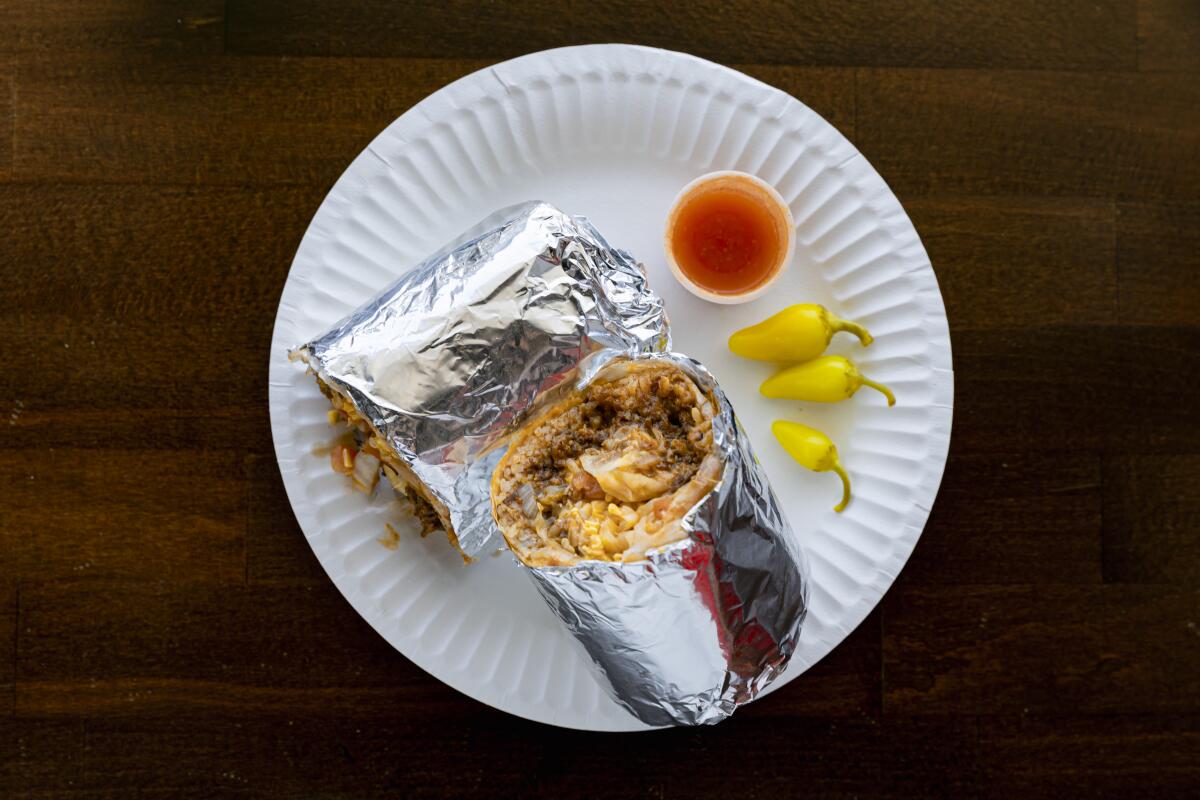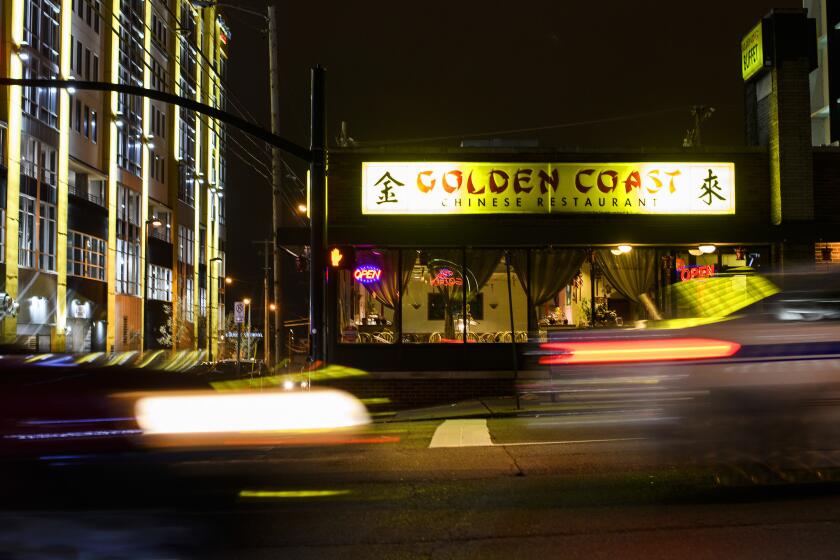Intersections: a semi-regular feature that tells stories around intersections of streets, people, cultures

- Share via
If we are friends, I have probably tried to interest you in the combination burrito at Olympic Burger in Koreatown.
Not only is it the approximate size and weight of a healthy newborn, but the burrito contains a surprisingly dense web of cultural references unique to Los Angeles.
Take the inclusion of pastrami — sliced thin and used almost like a condiment in burgers and to top fries, a style with roots in historic interactions between Jewish and Mexican populations in Boyle Heights.
Then there’s chili, not thick with a lot of beans, but the liquid kind that you often find at the single-name roadside burger and burrito stands all over Southern California like Jim’s, Tom’s, and Tam’s. Here it’s also served with cheese over rice.
And the meat, labeled “costilla galbi” on the menu, is a fusion of Korean short rib marinade and flavors from the Mexican short rib preparation, costilla de puerco.
Olympic Burger and Los Angeles in general are full of these organic interactions across cultural and language barriers. At Sopita Ramen down the street, there’s kimchi tofu ramen on a menu conceived by a Korean chef from South America. A few months ago, I wrote about Ocha Classic, a nearby Thai restaurant chain beloved by Latinos.
On a recent weekday I met Sahira Santana, 40, who was visiting her family home in Los Angeles from Australia, where she moved with her husband a few years ago.
Olympic Burger was one of her first stops on her trip home. She used to work at an insurance agency upstairs and became a regular. Eventually she converted her parents, immigrants from El Salvador who fell in love with the costilla galbi.
Now some of her cousins and relatives have married or formed close relationships with Asian Americans. Her mother, Roxana, 59, frequents Korean bakeries.
“It’s just how we grew up. We’re mixed, very open. We know to respect cultures,” Sahira said. “And I think that Asians are very similar to Hispanics.”
I think these quiet interactions are the building blocks of community in Los Angeles. There’s an easy camaraderie and automatic understanding that forms among those in or headed to the same place, for however long. In other words, there’s community around intersections.
To highlight these stories, I’m testing out a new occasional feature in this column called “Intersections.” In each piece I’ll focus on a particular intersection and tell a story about the people there.
I have some physical intersections in mind, and I welcome suggestions for interesting ones to visit — I’ll go anywhere within the borders of Los Angeles County. But I’m equally interested in intersections of age, culture, and background.
Future columns might visit an intersection in South L.A. with six drive-thru restaurants, a quinceañera at an Armenian wedding hall in the San Fernando Valley, a Mexican musician busking with a Chinese violinist in a San Gabriel strip mall. Maybe I’ll recount the night I was so spellbound by a Japanese nightclub singer in an Ethiopian restaurant singing Frank Sinatra that I dropped injera bread in my lap.
If you read this column you’ll probably notice I write about this subject a lot. I think it’s because I’m always searching for reasons to hope. Hope that this city won’t price out the people who make it run, whose lives make it beautiful. Hope that this messy, multiracial democracy will not tear itself apart, or at least, that it can come together in the aftermath and remain a place where people like my family can make a home. If any city gives me hope for that, it’s Los Angeles.
When I started this column, I wrote that we live our lives in parallel. I was talking about how my mother and I experienced totally different cities that only seemed to intersect at home, at the dinner table for an hour.
I think that’s still true. But what I’ve also come to accept is that, inevitably, we intersect. You can’t stop people from finding each other and forming a community.
Olympic Burger is a product of that. Korean immigrant Elvis Kim, the owner, came to the United States in the 1980s and was inspired by the casual food beloved around Southern California back then. (John Y., whose family currently owns the place, assured that, yes, his chosen English name really was Elvis. They play his songs at the restaurant sometimes.)
There are no Japanese people involved with the restaurant, but teriyaki was such a cross-cultural crowd pleaser during the time that Kim offered that too.
Ultimately there’s no story behind its flavor fusions — just the quirky and adventurous tastes of a Korean immigrant and a community diverse enough to share them.
Sometimes I still hear people describe Los Angeles, or California, or America as a melting pot, and I’ve never agreed with that term.
There’s plenty of heat, from climate change, drought, buildings burning in protest of police killings and record-breaking summer temperatures. But we are not melting into a single alloy — we’re creating new ones.
America is more like the combination burrito at Olympic burger, disparate elements sharing the same space. One bite is Mexican, another bite Jewish, the next Korean, and all of them pure Los Angeles.
More to Read
Sign up for Essential California
The most important California stories and recommendations in your inbox every morning.
You may occasionally receive promotional content from the Los Angeles Times.















